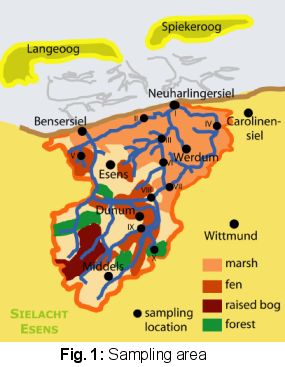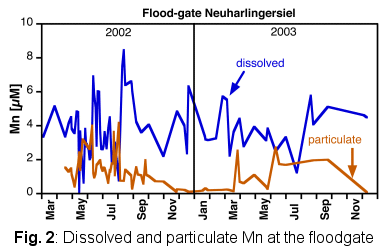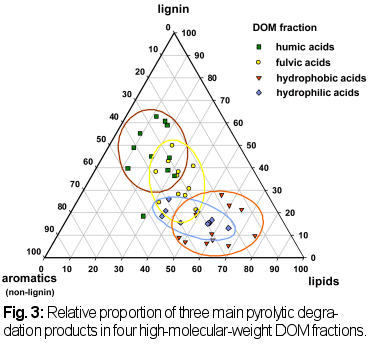
BioGeoChemistry of Tidal Flats
Geochemistry of the freshwater environment of the East Frisian coast

The discharge of freshwater from the catchment area of the Sielacht Esens on the East Frisian coast via the floodgate in Neuharlingersiel has got a significant influence on the Spiekeroog backbarrier tidal flat area. This is explained by specific geochemical properties like a comparatively high concentration of dissolved organic matter (DOM), typical of fen waters, and elevated values of several trace metals.
The aim of this part of the project is to budget the terrestrial input of major and trace elements, nutrients and DOM by the coastal tributaries into the Wadden Sea.
The main part of dissolved organic material in rivers is formed by high-molecular components such as humic substances. Due to their chemical properties they are able to complex metal ions and to stabilise them in solution. This leads to elevated concentrations of various dissolved trace metals like manganese, iron, and rare earth elements when compared with average values in river water. Concentrations vary according to soil types at the sampling location and influence from the sea. For example, salinity changes affect the formation of Fe and organic colloids, which leads to scavenging of other trace metals.
A special feature of the investigated coastal tributaries is the enrichment of dissolved and particulate manganese. While the dissolved manganese scatters around an average value of 4 µM, the particulate fraction shows a seasonal dependence with elevated contents in summer due to microbial activity. Especially in winter when precipitation is high, the freshwater contributes significantly to the manganese balance of the Wadden Sea.
 The dissolved organic material has a uniform chemical composition at the different sampling locations. Thermal degradation by pyrolysis leads to three main product groups. Humic and fulvic acids show a comparatively high proportion of the lignin fraction. Lipids are most abundant in the hydrophobic neutrals fraction.
The dissolved organic material has a uniform chemical composition at the different sampling locations. Thermal degradation by pyrolysis leads to three main product groups. Humic and fulvic acids show a comparatively high proportion of the lignin fraction. Lipids are most abundant in the hydrophobic neutrals fraction.
The isolation of high-molecular components of dissolved organic matter is carried out according to the standards of the International Humic Substances Society (IHSS). Analysis of organic compounds included determination of bulk parameters (e.g. DOC concentration,  13C) and detailed characterisation of separate DOM fractions on a molecular level. Several thermal (pyrolysis) and chemical (CuO-oxidation) decomposition methods were used.
13C) and detailed characterisation of separate DOM fractions on a molecular level. Several thermal (pyrolysis) and chemical (CuO-oxidation) decomposition methods were used.
| <<back | Publications | More details
|